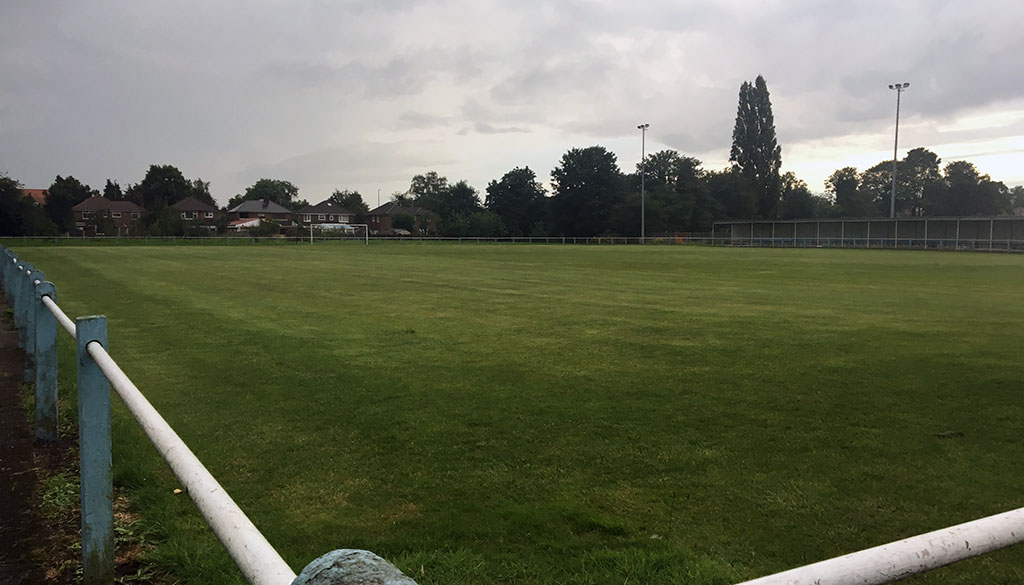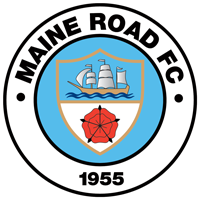
Emblematically Speaking - Maine Road
Tue 23rd January 2018 | Maine Road | By Stewart Taylor
The link between Maine Road FC and Manchester City FC is well known, in that Maine Road FC were formed as a Sunday League club by Manchester City supporters in 1955.
The name of the club, of course, refers to the home of Manchester City prior to the re-location to the City of Manchester Stadium, to the East of the City.
Given this then, it follows that the emblem of Maine Road FC is, at the very least, related to that of Manchester City.
As befits many top flight clubs, the emblem of Manchester City has changed a number of times down the years but the current emblem, called a “modern original” by some, harks back to previous designs and differs only slightly from that of Maine Road FC.
What we can readily see in the Maine Road FC emblem is a roundel shape with a clear reference to the name of the club and the year of foundation around the edges.
The overall colour ways of sky blue and white are a reflection of the playing colours of the club.
In the centre we see a traditional shield (escutcheon) divided into two. The upper portion shows a sailing ship on the now established wavy lines which represent a river or a sea – normally. In this case, the wavy lines represent the iconic Manchester Ship Canal.
We have previously examined the significance of waterways to the development of towns and cities in the North West of England and it could well be said that the Manchester Ship Canal could rival the mighty River Mersey in its importance.
Although established rather late in what we might call “the industrialised era” in this country, the significance of the Manchester Ship Canal to the fortunes of both Manchester and Liverpool should not be underestimated.
The contention that the Ship Canal was rather late onto the industrial scene needs to be justified a little in the context of the first “inter city” rail link in the world being established between Manchester and Liverpool, over 60 years before the Ship Canal was opened.
Whilst older canals, and the more recently established railway, were important in the transportation of goods, then the advent of the Ship Canal saw huge quantities of both raw materials and finished goods transported in one go.
The largest vessels to use the Ship Canal were of around 12,000 gross tons – a significant and vital increase over what could be carried by either canal or railway in one trip.
In its heyday, Manchester, thanks to the Ship Canal, became the third busiest port in the UK despite being about 40 miles inland.
The bottom section of the shield re-introduces us to the Red Rose representing Lancashire. Specifically, the red rose used in the Maine Road emblem is a variant of the true Red Rose of Lancaster in that the original representation (Medieval) shows a white centre which is missing on the Maine Road version.
This is not to get confused with the Tudor Rose which is a Red Rose (Lancashire) with a White Rose (York) displayed in the centre introduced by Henry VII in the late 15th century.
Quite why this central portion does not appear in the emblem of Maine Road is not at all clear, but variations on the original Red Rose of Lancaster – Rosa gallica officinalis – abound.
And that is that. Another example of a simple but elegant design which does exactly what it intends to do.
 Emblematically Speaking - Maine Road
Emblematically Speaking - Maine Road
Tue 23rd January 2018 | Maine Road
By Stewart Taylor

The link between Maine Road FC and Manchester City FC is well known, in that Maine Road FC were formed as a Sunday League club by Manchester City supporters in 1955.
The name of the club, of course, refers to the home of Manchester City prior to the re-location to the City of Manchester Stadium, to the East of the City.
Given this then, it follows that the emblem of Maine Road FC is, at the very least, related to that of Manchester City.
As befits many top flight clubs, the emblem of Manchester City has changed a number of times down the years but the current emblem, called a “modern original” by some, harks back to previous designs and differs only slightly from that of Maine Road FC.
What we can readily see in the Maine Road FC emblem is a roundel shape with a clear reference to the name of the club and the year of foundation around the edges.
The overall colour ways of sky blue and white are a reflection of the playing colours of the club.
In the centre we see a traditional shield (escutcheon) divided into two. The upper portion shows a sailing ship on the now established wavy lines which represent a river or a sea – normally. In this case, the wavy lines represent the iconic Manchester Ship Canal.
We have previously examined the significance of waterways to the development of towns and cities in the North West of England and it could well be said that the Manchester Ship Canal could rival the mighty River Mersey in its importance.
Although established rather late in what we might call “the industrialised era” in this country, the significance of the Manchester Ship Canal to the fortunes of both Manchester and Liverpool should not be underestimated.
The contention that the Ship Canal was rather late onto the industrial scene needs to be justified a little in the context of the first “inter city” rail link in the world being established between Manchester and Liverpool, over 60 years before the Ship Canal was opened.
Whilst older canals, and the more recently established railway, were important in the transportation of goods, then the advent of the Ship Canal saw huge quantities of both raw materials and finished goods transported in one go.
The largest vessels to use the Ship Canal were of around 12,000 gross tons – a significant and vital increase over what could be carried by either canal or railway in one trip.
In its heyday, Manchester, thanks to the Ship Canal, became the third busiest port in the UK despite being about 40 miles inland.
The bottom section of the shield re-introduces us to the Red Rose representing Lancashire. Specifically, the red rose used in the Maine Road emblem is a variant of the true Red Rose of Lancaster in that the original representation (Medieval) shows a white centre which is missing on the Maine Road version.
This is not to get confused with the Tudor Rose which is a Red Rose (Lancashire) with a White Rose (York) displayed in the centre introduced by Henry VII in the late 15th century.
Quite why this central portion does not appear in the emblem of Maine Road is not at all clear, but variations on the original Red Rose of Lancaster – Rosa gallica officinalis – abound.
And that is that. Another example of a simple but elegant design which does exactly what it intends to do.


